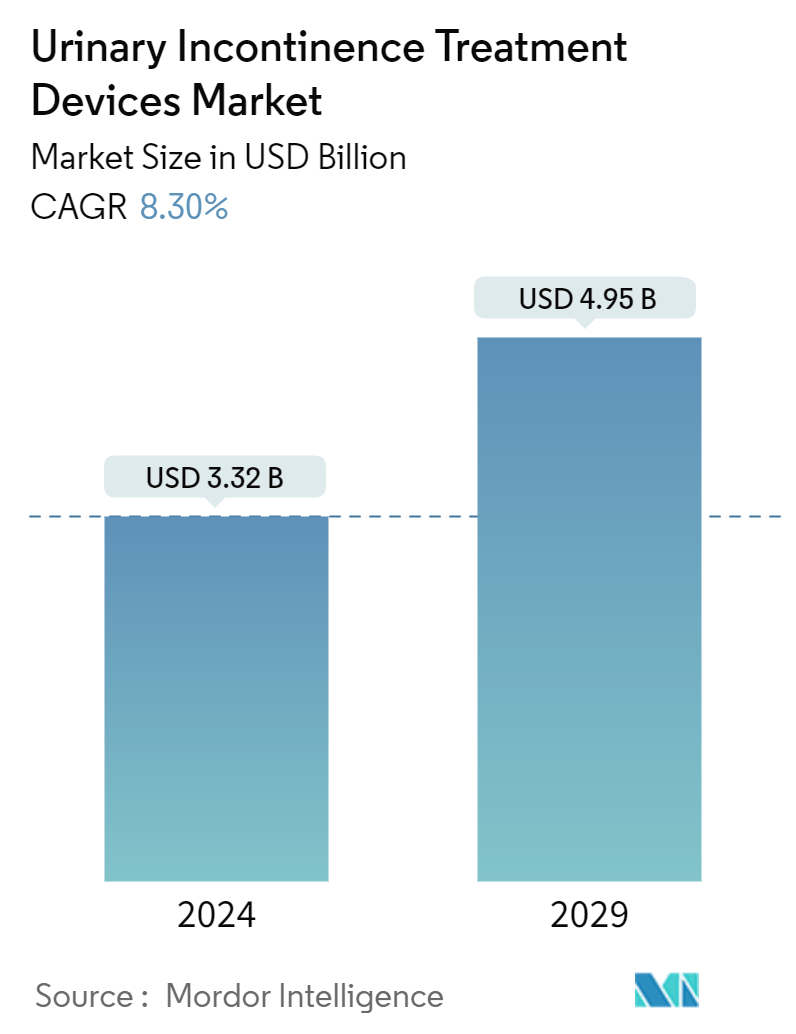Market Size of Urinary Incontinence Treatment Devices Industry

| Study Period | 2019 - 2029 |
| Market Size (2024) | USD 3.32 Billion |
| Market Size (2029) | USD 4.95 Billion |
| CAGR (2024 - 2029) | 8.30 % |
| Fastest Growing Market | Asia-Pacific |
| Largest Market | North America |
Major Players
*Disclaimer: Major Players sorted in no particular order |
Urinary Incontinence Treatment Devices Market Analysis
The Urinary Incontinence Treatment Devices Market size is estimated at USD 3.32 billion in 2024, and is expected to reach USD 4.95 billion by 2029, growing at a CAGR of 8.30% during the forecast period (2024-2029).
Factors such as the increasing prevalence of urinary incontinence, leading to a growing Urinary Incontinence Devices Market, the rise in the geriatric population, and the rise in demand for minimally invasive surgery and product development are expected to boost market growth.
The rising prevalence of urinary incontinence is one of the major factors driving market growth. For instance, according to an article published by SpringerLink in March 2022, a study was conducted in Sweden that mentioned that urinary incontinence (UI) was the involuntary loss of urine and had an estimated prevalence of about 25 to 45% among adult women. Thus, the high burden of urinary incontinence is expected to boost the adoption of Urinary Incontinence Devices, spurring the growth of the Urinary Incontinence Devices Market.
Moreover, the rising geriatric population is another major factor driving market growth, as urinary incontinence is much more common in elderly people. For instance, according to the World Population Prospects 2022 Report published by the UN in 2022, the share of the global population aged 65 years or above was projected to rise from 10% in 2022 to 16% in 2050. By 2050, the number of people aged 65 years or over worldwide is projected to be more than twice the number of children under age five and about the same as the number of children under age 12. Thus, the rising geriatric population is expected to enhance market growth.
Furthermore, the rising developments by major market players, particularly in the area of Neuromodulation Devices, are also expected to boost market growth. For instance, in March 2022, Medtronic announced that its investigational implantable tibial neuromodulation (TNM) device had been implanted in the first patient for its TITAN 2 pivotal study. The multicentre, prospective study is designed to assess the device's safety and efficacy in people with urinary incontinence-related overactive bladder (OAB).
Thus, the aforementioned factors, such as the rising prevalence of urinary incontinence, coupled with the rising geriatric population and the increasing developments by major market players, are expected to boost market growth. However, factors such as a lack of awareness about devices, the social stigma associated with the disease, and the risks and complications related to the procedures are expected to impede market growth over the forecast period.
Urinary Incontinence Treatment Devices Industry Segmentation
As per the scope of the report, urinary incontinence is a condition that defines any involuntary leakage of urine. The condition is categorized according to its underlying cause. Urinary incontinence results from difficulties in either filling, storing, or emptying the bladder, and some people may even suffer from a combination of these problems. The urinary incontinence treatment devices market is segmented by product, end user, and geography. By product, the market is segmented into urethral slings, electrical stimulation devices, artificial urinary sphincters, and catheters and other products. By end user, the market is segmented into hospitals, ambulatory surgical centers, and other end users. By geography, the market is segmented into North America, Europe, Asia-Pacific, the Middle East and Africa, and South America. The report also covers the estimated market sizes and trends for 17 countries across major regions globally. The report offers the value (USD) for the above segments.
| By Product | |
| Urethral Slings | |
| Electrical Stimulation Devices | |
| Artificial Urinary Sphincters | |
| Catheters and Other Products |
| By End User | |
| Hospitals | |
| Ambulatory Surgical Centers | |
| Other End Users |
| By Geography | ||||||||
| ||||||||
| ||||||||
| ||||||||
| ||||||||
|
Urinary Incontinence Treatment Devices Market Size Summary
The urinary incontinence treatment devices market is poised for significant growth, driven by several key factors. The increasing prevalence of urinary incontinence, particularly among the aging population, is a primary catalyst for market expansion. As the global geriatric population continues to rise, the demand for effective treatment solutions is expected to increase. Additionally, the trend towards minimally invasive surgical procedures and ongoing product development by major market players further supports market growth. Companies are actively investing in research and development to enhance the efficacy and safety of urinary incontinence devices, which is anticipated to bolster market adoption.
Regionally, North America is expected to witness substantial market growth due to the high prevalence of urinary incontinence and a significant geriatric demographic. The demand for minimally invasive surgeries in this region also contributes to market expansion. Strategic initiatives by key players, such as mergers, acquisitions, and product launches, are enhancing market dynamics. The market is semi-consolidated, with major companies like Boston Scientific Corporation, Medtronic PLC, and Coloplast Corp. leading the charge. These companies are continuously innovating and expanding their product portfolios to meet the growing demand for urinary incontinence treatment devices.
Urinary Incontinence Treatment Devices Market Size - Table of Contents
-
1. MARKET DYNAMICS
-
1.1 Market Overview
-
1.2 Market Drivers
-
1.2.1 Increasing Prevalence of Urinary Incontinence and Rise in Geriatric Population
-
1.2.2 Rise in Demand for Minimally Invasive Surgery and Product Development
-
-
1.3 Market Restraints
-
1.3.1 Lack of Awareness about Devices and Social Stigma Associated with the Disease
-
1.3.2 Risks and Complications from the Procedures
-
-
1.4 Porter's Five Forces Analysis
-
1.4.1 Threat of New Entrants
-
1.4.2 Bargaining Power of Buyers/Consumers
-
1.4.3 Bargaining Power of Suppliers
-
1.4.4 Threat of Substitute Products
-
1.4.5 Intensity of Competitive Rivalry
-
-
-
2. MARKET SEGMENTATION (Market Size by Value - USD)
-
2.1 By Product
-
2.1.1 Urethral Slings
-
2.1.2 Electrical Stimulation Devices
-
2.1.3 Artificial Urinary Sphincters
-
2.1.4 Catheters and Other Products
-
-
2.2 By End User
-
2.2.1 Hospitals
-
2.2.2 Ambulatory Surgical Centers
-
2.2.3 Other End Users
-
-
2.3 By Geography
-
2.3.1 North America
-
2.3.1.1 United States
-
2.3.1.2 Canada
-
2.3.1.3 Mexico
-
-
2.3.2 Europe
-
2.3.2.1 Germany
-
2.3.2.2 United Kingdom
-
2.3.2.3 France
-
2.3.2.4 Italy
-
2.3.2.5 Spain
-
2.3.2.6 Rest of Europe
-
-
2.3.3 Asia-Pacific
-
2.3.3.1 China
-
2.3.3.2 Japan
-
2.3.3.3 India
-
2.3.3.4 Australia
-
2.3.3.5 South Korea
-
2.3.3.6 Rest of Asia-Pacific
-
-
2.3.4 Middle East and Africa
-
2.3.4.1 GCC
-
2.3.4.2 South Africa
-
2.3.4.3 Rest of Middle East and Africa
-
-
2.3.5 South America
-
2.3.5.1 Brazil
-
2.3.5.2 Argentina
-
2.3.5.3 Rest of South America
-
-
-
Urinary Incontinence Treatment Devices Market Size FAQs
How big is the Urinary Incontinence Treatment Devices Market?
The Urinary Incontinence Treatment Devices Market size is expected to reach USD 3.32 billion in 2024 and grow at a CAGR of 8.30% to reach USD 4.95 billion by 2029.
What is the current Urinary Incontinence Treatment Devices Market size?
In 2024, the Urinary Incontinence Treatment Devices Market size is expected to reach USD 3.32 billion.

